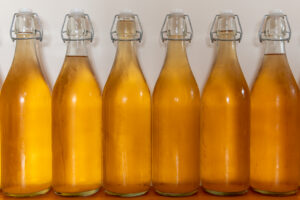Introduction
Fermentation is an ancient preservation technique that adds flavor, probiotics, and extended shelf life to various foods and beverages. It also has many health benefits. One key component of fermentation is a starter culture, such as a ginger bug, which is used to kick-start the fermentation process. In this step-by-step guide, we’ll walk you through how to make a ginger bug, maintain it, and use it in your ferments.
Step 1: Gather the Ingredients and Equipment
- To make a ginger bug, you will need the following ingredients and equipment:
- 2-3 tablespoons of grated fresh ginger root (unpeeled)
- 2-3 tablespoons of granulated sugar
- 2 cups of filtered water (chlorine-free)
- A clean glass jar with a capacity of at least 16 ounces
- A breathable cover like a coffee filter or cheesecloth
- A rubber band or string to secure the cover
Step 2: Creating the Ginger Bug Starter
Thoroughly clean the glass jar with warm, soapy water, rinse it well, and allow it to air dry.
I like to sterilize with boiling water.
Add 2-3 tablespoons of grated ginger root to the jar.
Add an equal amount (2-3 tablespoons) of granulated sugar to the jar.
Pour 2 cups of filtered water into the jar. The chlorine in unfiltered water will kill the microorganisms.
Stir the mixture vigorously with a non-metal spoon until the sugar dissolves. Alternatively, make sugar water by boiling a quart of water with a ½ cup of sugar. Let cool and use as the water for ginger bug.
Cover the jar with a breathable cover such as a coffee filter or cheesecloth, securing it with a rubber band or string.
Over time you will notice bubbling. This is the fermentation process.
Step 3: Feeding and Maintaining the Ginger Bug
Every 24 hours, add 1 tablespoon of grated ginger root and sugar to the jar. Stir well to combine.
Stirring introduces oxygen and helps the ginger bug ferment properly.
Repeat this feeding process daily for about 5-7 days, or until the ginger bug becomes active. You will notice bubbling and a slightly tangy aroma when fermentation is underway.
If any mold develops or the ginger bug smells unpleasant, discard it and start again.
You can store you ginger bug in the fridge for up to two weeks.
To refresh just bring to room temperature and feed with fresh grated ginger and sugar.
Give it several days to regain its strength, which will be obvious when it is bubbling actively.
Step 4: Using the Ginger Bug in Fermentation
Once your ginger bug is active, it’s ready to use as a starter culture for various fermented beverages or foods.
Transfer the desired amount of ginger bug to your fermenting recipe, usually replacing any other starter culture called for in the recipe.
Mix the ginger bug into your fermenting ingredients and proceed with the fermentation process as directed in your recipe.
Remember to reserve some ginger bug for future batches. You can replenish it by feeding it daily or weekly with ginger and sugar and filtered water even if you’re not currently fermenting.
You can easily use your ginger bug to ferment fruit juices making fizzy probiotic drinks!
You will just need a flip top bottle with a firm seal such as used in beer brewing.
Here is a ginger bug recipe to try:
- Sterilize your bottles with boiling water.
- Prepare 2 quarts of sugar water by boiling filtered water and adding one cup of sugar. Stir until sugar dissolves. Let cool to easily touch temperature. Any warmer and you will kill the ginger bug.
- Fill you bottles with 1/3 ginger bug. 1/3 sugar water and 1/3 juice of your choice. I use fresh organic oranges that I have squeezed the juice from.
- Close the flip top and let sit at room temperature for 2-3 days.
- Be sure to burp the bottle daily! When the bottle pops you know your fermentation has started.
- You can then refrigerate but continue to burp daily. This is very important as the bottles can explode if too much pressure builds up.
- The longer the bottles sit the more the sugars are eaten by the fermenting microorganisms and the less sweet it will be. Even diabetics can enjoy this drink when it tastes less sweet and more beer-like. My husband drinks while still fairly sweet and it does not seem to affect his glucose levels at all.
- It does develop a minimal alcohol content as it ferments.
Tips for Success:
Use organic ingredients whenever possible to avoid any potential contaminants.
Maintain a consistent feeding schedule for your ginger bug, preferably around the same time each day.
Keep the ginger bug at room temperature, ideally between 68-78°F (20-26°C), as warmer temperatures can accelerate fermentation.
Stir the ginger bug with a non-metal spoon, as metal can react with the ferment and affect its flavor.
If you plan to take a break from fermenting, feed the ginger bug once a week to keep it active and healthy.
Fermenting starters from Cultures for Life for you to check out. Great site!
Conclusion:
In conclusion, with a ginger bug, you can unlock a world of delicious and probiotic-rich fermented creations. By following the simple steps outlined above, you can easily create, maintain, and use a ginger bug in your fermenting adventures. Experiment with different recipes and enjoy the unique flavors and health benefits that fermentation offers. Cheers to your homemade ferments!

